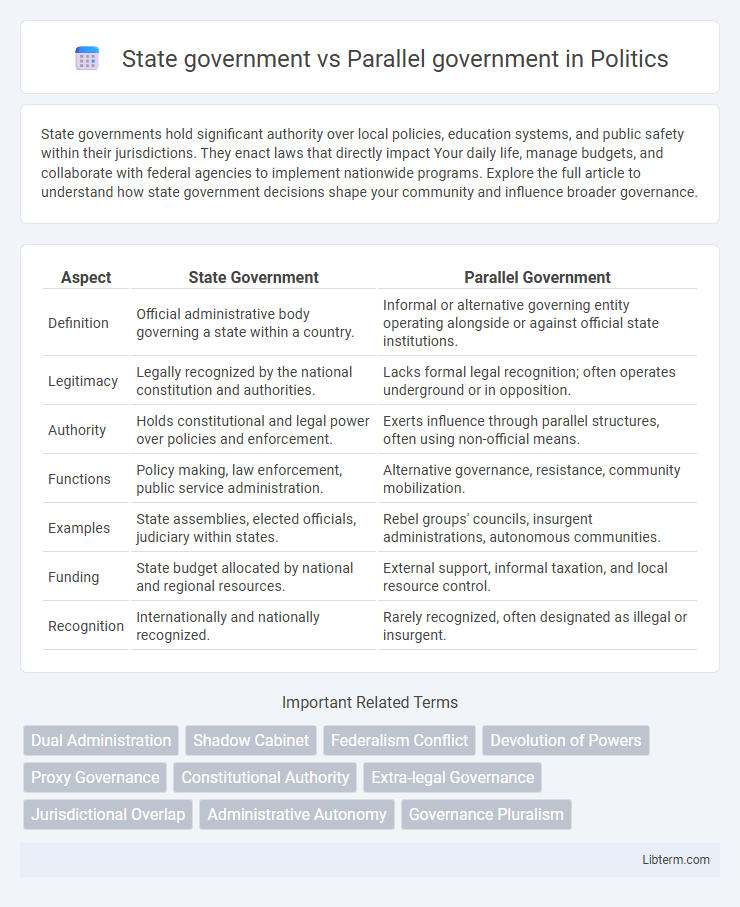State governments hold significant authority over local policies, education systems, and public safety within their jurisdictions. They enact laws that directly impact Your daily life, manage budgets, and collaborate with federal agencies to implement nationwide programs. Explore the full article to understand how state government decisions shape your community and influence broader governance.
Table of Comparison
| Aspect | State Government | Parallel Government |
|---|---|---|
| Definition | Official administrative body governing a state within a country. | Informal or alternative governing entity operating alongside or against official state institutions. |
| Legitimacy | Legally recognized by the national constitution and authorities. | Lacks formal legal recognition; often operates underground or in opposition. |
| Authority | Holds constitutional and legal power over policies and enforcement. | Exerts influence through parallel structures, often using non-official means. |
| Functions | Policy making, law enforcement, public service administration. | Alternative governance, resistance, community mobilization. |
| Examples | State assemblies, elected officials, judiciary within states. | Rebel groups' councils, insurgent administrations, autonomous communities. |
| Funding | State budget allocated by national and regional resources. | External support, informal taxation, and local resource control. |
| Recognition | Internationally and nationally recognized. | Rarely recognized, often designated as illegal or insurgent. |
Introduction to State Government and Parallel Government
State government functions as the official governing body responsible for public administration, law enforcement, and policy implementation within defined territorial boundaries. Parallel government refers to unofficial or alternative power structures that operate alongside or in opposition to the formal state apparatus, often emerging in contexts of political instability or conflict. Understanding the distinctions between state government and parallel government is crucial for analyzing governance legitimacy and control dynamics in a given region.
Defining State Government: Structure and Functions
State government operates as an organized political entity with defined authority over a specific geographic region, typically structured into executive, legislative, and judicial branches. The executive branch, headed by the governor, implements laws and administers public policy, while the legislative branch enacts state laws, and the judiciary interprets these laws, ensuring justice and constitutional compliance. This formal government structure contrasts with a parallel government, which functions unofficially or in opposition, lacking legal recognition or statutory authority.
Understanding Parallel Government: Origin and Characteristics
Parallel government originates as an alternative authority established to challenge or replace an existing state government, often emerging during political crises or conflicts. It operates independently, replicating governmental functions such as law enforcement, taxation, and administration to assert legitimacy and control. These governments are characterized by their illegitimacy in official law but gain popular support through ideological alignment or opposition to the state regime.
Legal Framework: Authority and Jurisdiction
State government operates under a defined constitutional legal framework granting it sovereign authority and jurisdiction within its territorial boundaries, enabling lawmaking, enforcement, and adjudication recognized by national and international law. Parallel government lacks formal legal recognition and operates outside established legal authority, often resulting in contested jurisdiction and legitimacy issues. The legal framework distinguishes state government's legitimate authority through codified laws, whereas parallel governments function through alternative or extra-legal mechanisms without official constitutional endorsement.
Roles and Responsibilities: A Comparative Analysis
State government manages public services, enforces laws, and administers policies within legal frameworks, focusing on welfare, infrastructure, education, and healthcare. Parallel government operates unofficially or underground, often challenging state authority by providing alternative governance, social services, or mobilizing political dissent. While state governments maintain legitimacy through constitutional power, parallel governments fulfill roles in areas neglected by the state or during political instability, impacting governance and public order differently.
Governance Models: Centralization vs Decentralization
State governments typically implement centralized governance models where authority and decision-making power are concentrated within a defined institutional framework, ensuring uniform policy enforcement and resource allocation across regions. In contrast, parallel governments often exhibit decentralized structures, distributing power across multiple autonomous or semi-autonomous entities that function independently or semi-independently from the official state apparatus. This distinction influences the effectiveness, accountability, and legitimacy of governance, with centralized models enabling streamlined administration while decentralized parallel systems may foster localized control but risk fragmentation.
Impact on Public Administration and Policy Implementation
State governments function as official governing bodies with constitutional authority, ensuring structured public administration and consistent policy implementation across regions. Parallel governments, often informal or unauthorized, disrupt administrative processes by creating conflicting authority and confusion, undermining governance efficiency. The presence of parallel governments hinders coherent policy execution, delays public service delivery, and fosters institutional instability.
Challenges and Conflicts between State and Parallel Governments
State governments face significant challenges when parallel governments operate simultaneously, as overlapping authorities create legal ambiguities and power struggles. Conflicts often arise regarding jurisdiction, resource allocation, and policy enforcement, undermining governance efficacy and public trust. Such dual systems can lead to administrative paralysis, weakened institutional structures, and escalated political tensions, complicating the implementation of law and order.
Case Studies: Real-World Examples of Parallel Governments
Parallel governments operate alongside official state governments, often challenging legitimacy and control over territory. Case studies include the Autonomous Administration of North and East Syria (Rojava), which functions with independent governance structures amidst the Syrian civil war, and the Taliban's shadow governance in Afghanistan, providing judicial and administrative services competing with the official government. These examples illustrate how parallel governments assert authority through alternative institutions, disrupting conventional state sovereignty and complicating conflict resolution.
Conclusion: Implications for Governance and Democracy
State governments embody formal authority and legitimacy, ensuring structured governance through recognized institutions, while parallel governments often arise as alternative power centers challenging official rule. The existence of parallel governments can undermine state sovereignty, disrupt public order, and erode democratic processes by fostering divided loyalties and alternative legal systems. Effective governance and the health of democracy depend on strengthening state institutions, promoting political inclusivity, and addressing the root causes that give rise to parallel governance structures.
State government Infographic

 libterm.com
libterm.com